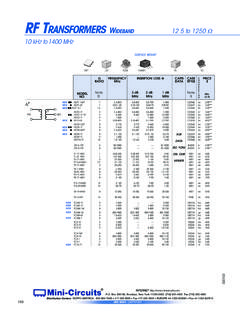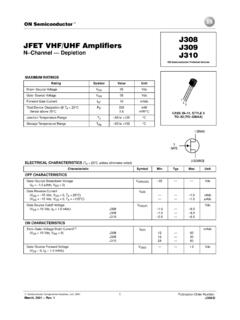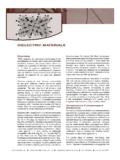Transcription of Circulators and Isolators, unique passive devices …
1 Circulators and Isolators, unique passive devicesAPPLICATION NOTEAN980351998 Mar 232 Philips SemiconductorsCirculators and Isolators, unique passive devicesApplication NoteAN980350. Contents 1. Introduction1 2. Definitions1 3. Behaviour of ferrites2 4. Principles of operation and Resonance Field displacement Phase shift Faraday rotation Ring Junction Edge guided mode Lumped element circulator14 5. Charcteristics16 6. Correlation of parameters of a symmetrical The lossless symmetrical The lossy symmetrical 3-port-circulator19 7.
2 Decoupling of generator and Decoupling of amplifier Decoupling of a transmitter or receiver from its Transmitter and receiver on the same Combiner for 2 or more transmitters in the VHF and Combiner for radio Combining amplifier stages in a solid-state Operation of Locking and priming of Variable attenuator and phase shifter28 Bibliography291998 Mar 233 Philips SemiconductorsCirculators and Isolators, unique passive devicesApplication : Energy flow ina. a 3-port-circulatorb.
3 A 4-port-circulator1. IntroductionCirculators and isolators are passive devices used in modern rf and microwave equipmentsince some decades. By using them the stability, performance, and reliability of thesystems can be improved, and often better and cheaper solutions are possible. In addition,in certain applications, one-port-amplifiers, the use of Circulators is a booklet will help you to understand these important devices and give you some hintsto use them DefinitionsThe circulator is defined as a passive device with 3 or more ports, where power istransferred from one port to the next in a prescribed order.
4 That means for a 3-port-circulator (see ): power entering port 1 leaves port 2, port 3 is decoupled; powerentering port 2 leaves port 3, port 1 is decoupled; and power entering port 3 leaves port 1,1998 Mar 234 Philips SemiconductorsCirculators and Isolators, unique passive devicesApplication NoteAN98035 : Energy flow in an isolator : Symbols for a. 3-port-circulatorb. 4-port-circulatorc. isolator : Planar model of Weiss domainsport 2 is decoupled. For a 4-port-circula-tor it is similar (see ): powerentering port 1 leaves port 2, port 3 and 4are decoupled isolator is defined as a passive two-port, where power is transmitted in onedirection and absorbed in the other direc-tion.
5 That means power entering port 1 leaves port 2, but power entering port 2 is absor-bed (see ).An isolator can be a specially developed item. But we get also an isolator if we connecta matched load to port 3 of a 3 gives the symbols used for Circulators and isolators in circuit these definitions Circulators and isolators are non-reciprocal devices , that means, theirbehaviour in one direction is very different from that in the other Behaviour of ferritesThe way of operation of circu-lators and isolators is based onthe unique properties of mi-crowave ferrites.
6 Therefore wewill have a look on the behav-ior of ferrites under static andalternating fields at are magnetic materialwith very high ohmic resis-tance. Therefore they havenearly no eddy currents andare suitable for the operationat rf and microwave ferromagnetic material1998 Mar 235 Philips SemiconductorsCirculators and Isolators, unique passive devicesApplication NoteAN98035Bx'myHx&j6 HyBy'j6Hx%myHyBz'my0 HzBxByBz'my&j60j6my000my0 HxHyHz : Precession of the spin- ning electronthey consist of magnetic domains called Weissdomains, for Pierre Weiss discovered them1908.
7 The individual domains with dimensionsof 1 to 100 m are inherently magnetized bymutual exchange effects between adjacent elec-tron spins. They are separated from each otherby Bloch walls, named after their discovererFelix Bloch. If there is no external magneticfield, the individual Weiss domains are orientedrandomly. Therefore the resulting magnetizationis zero (see ).If we apply an external magnetic field of suffi-cient strength, the magnetic moments of the in-dividual Weiss domains are oriented in the di-rection of the external field and Bloch walls aredisplaced, resulting in an increase of thedomains aligned with the external field.
8 Duringthis alignment the spinning electrons whosedirection is changed makes a damped proces-sional motion around the direction of the mag-netic field as we know it in the mechanics froma gyro. If the procession has stopped, all mag-netic moments are in the direction of the exter-nal magnetic field and the ferrite has its satura-tion a small alternating rf field of a suitable fre-quency is applied perpendicular to the direction z of the strong static magnetic field H , in the x-direction as shown in figure 5, the magnetic Moment M processes around thedirection of H.
9 Therefore there is not only a component of the magnetic moment in theix-direction but also one in the y-direction. Now the in the relationship between induc-tion B and magnetic field H is no longer scalar but a tensor, known as the Polder tensor[1]. And we can write the relationship between B and H as follows:( )or expressed as a tensor( )1998 Mar 236 Philips SemiconductorsCirculators and Isolators, unique passive devicesApplication NoteAN98035(2'jT,my0myeffz'my2&62my(z'jT , : and of a microwave ferrite as a function of the static magnetic field Heff2effziThe value of the induction component perpendicular to the magnetic rf field is deter-mined by the value of 6.))
10 The values of = ' - j " and 6 = 6' - j6" are complex anddepend on the static magnetic field, the frequency, and the material properties of the magnetic plane of an electromagnetic wave is parallel to H , the relative perme-iability is = , for the ferrite is saturated. The propagation speed is eff20( )The ferrite has no gyromagnetic effect on the the magnetic plane of the electromagnetic wave is perpendicular to H , the relativeipermeability is ( )and the propagation constant( )1998 Mar 237 Philips SemiconductorsCirculators and Isolators, unique passive devicesApplication NoteAN98035(%'jT,my%(&'jT,my& : and of a microwave ferrite as a function of the static magnetic field H+-iFigure 6 shows the real and imaginary parts of and as a function of H.))



